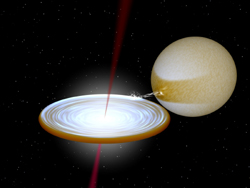Observational Astronomy and Astrophysics
Faculty
- Boyajian - (Fundamental properties of stars; exoplanet detection and characterization)
- Clayton (Emeritus) - (Dust everywhere, R CrB stars)
- Hinkel - (Exoplanets and their parent stars, Hypatia Catalog, stellar elemental abundances, exoplanet interiors and mineralogy, M-dwarfs)
- Hynes - (Multi-wavelength observations of Black Holes and Neutron Stars)
- Penny - (Exoplanets, Gravitational Microlensing)
- Schaefer (Emeritus) - (Gamma-ray bursts, supernovae, novae, Kuiper Belt Objects, sunspots, history of astronomy)
The observational astrophysical group studies a wide variety of sources, including black holes (in binaries, active galaxies, and gamma-ray bursts), the biggest explosions (supernovae, novae, and gamma-ray bursts), and variable stars (R CrB stars, binaries of all types), plus the standard stars on which all photometry is based. The observational astronomy group involves multiwavelength observations using ground-based telescopes (Cerro Tololo Inter-American Observatory in Chile, Kitt Peak National Observatory in Arizona, Keck Observatory and Canada France Hawaii Telescope in Hawaii, Lowell Observatory in Arizona, Las Campanas in Chile, and McDonald Observatory in west Texas) and space telescopes (Hubble Space Telescope, Spitzer Space Telescope, Chandra X-ray Observatory, the Swift gamma-ray burst observatory, and FUSE) for data from gamma-ray, x-ray, ultraviolet, optical, and infrared wavelengths.
Boyajian's work focuses on measuring the fundamental properties of stars using various techniques such as optical/IR interferometry, spectroscopy, photometry, and asteroseismology. These data are used to calibrate standard stellar models and characterize exoplanetary systems. She is a science team member of the Planet Hunters citizen science group (www.planethunters.org), and namesake of the enigmatic star, KIC 8462852.
Clayton and collaborators are working on understanding the nature of dust in many astrophysical situations and how the dust affects the radiative transfer of energy in galaxies. This work on dust is being applied to many places in our Universe; including Mars, R CrB stars, and distant supernovae.
Hinkel studies the composition of stars, having created the Hypatia Catalog, the largest multidimensional database of element abundances in nearby FGKM-type stars. She relates the stellar make-up to the interior structure, mineralogy, and surface conditions of their small planets, since stars and planets are formed from the same material. She is especially focused on M-dwarf stars, which are difficul to observe from the ground but are the best place to detect Earth-sized planets.
Hynes is studying the details of black holes and neutron stars in binary systems with the Hubble Space Telescope plus the Chandra and RXTE X-ray satellites, as well as with several ground-based optical observatories. One facet of this work is to probe the instabilities in accretion onto black holes by studying fast variability and correlating variability across X-ray and optical wavelengths. Another aspect is to study multiwavelength spectral energy distributions to investigate the temperature structure of the disk and hence how it is heated.
Landolt's research effort has been concerned with the measurement of stellar brightness and colors, i.e., stellar photometry. His main interest is the improvement and definition of photometric standard stars. These standard stars are used as calibration yardsticks when studying celestial objects, or indeed any objects projected against the celestial sphere, whose characteristics are unknown. Research projects also are under way in the areas of star clusters, variable stars, novae, supernovae, and eclipsing binaries.
Penny works on exoplanet demographics, using wide-field imaging surveys to search for planets via transits and gravitational microlensing. He works on surveys using the wide-field camera DECam on the CTIO Blanco 4m telescope, and MegaCam on the Canada-France-Hawaii telescope, as well as preparing for the microlensing survey that will be carried out by the NASA WFIRST mission.
Schaefer's work is to use the biggest stellar explosions as a tool to measure cosmologically interesting parameters. With Gamma Ray Bursts; star formation rate and the Hubble diagram 0.4<z<6. With supernovae; H0, Ω, and Λ. With recurrent novae; determine the progenitors of Type Ia supernovae.
